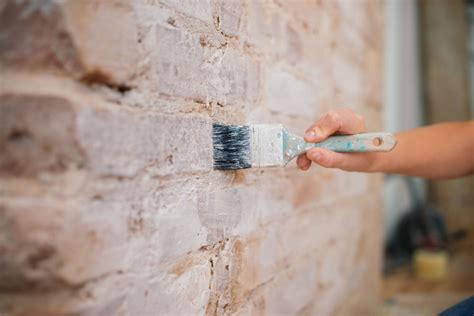Painting brick is a popular way to enhance the aesthetic appeal of a building, whether it's a residential home, commercial property, or historic landmark. Brick, as a material, has been used in construction for centuries due to its durability, low maintenance requirements, and versatility. However, over time, the color and appearance of brick can fade, become uneven, or no longer match the desired architectural style. This is where painting brick comes into play, offering a cost-effective and transformative solution. But, like any significant alteration to a building's exterior, it requires careful consideration and planning to ensure the desired outcome.
Preparation and Considerations

Before painting brick, it’s essential to understand the process and the implications of such a project. The first step involves preparing the surface. This includes cleaning the brick thoroughly to remove dirt, grime, and any efflorescence (a salty deposit that can form on the surface of brick). The cleaning process typically involves using a mild detergent and water, sometimes in combination with a pressure washer, though caution must be exercised to avoid damaging the brick or the mortar. After cleaning, any damaged or crumbling mortar should be repaired, and the surface should be allowed to dry completely.
Choosing the Right Paint
The selection of paint is critical. Not all paints are suitable for brick surfaces. The ideal paint should be breathable, allowing moisture to escape from the brick, thereby reducing the risk of trapped water and subsequent damage. Masonry paints or elastomeric coatings are often recommended due to their breathability and flexibility. These paints can expand and contract with the brick as it responds to temperature changes, reducing the likelihood of cracking. It’s also important to choose a paint that is specifically designed for exterior use and can withstand the elements.
| Paint Type | Characteristics | Suitability for Brick |
|---|---|---|
| Masonry Paint | Breathable, durable, water-resistant | Highly suitable |
| Elastomeric Coating | Flexible, waterproof, UV resistant | Highly suitable |
| Latex Paint | Water-based, easy to clean up, less durable | Somewhat suitable, but less ideal |

Application and Aftercare

Once the surface is prepared and the appropriate paint is chosen, the application process can begin. It’s advisable to apply a primer first, especially if the brick is very porous or if the paint is a significantly different color from the original brick tone. The primer helps ensure better paint adhesion and coverage. The paint should be applied according to the manufacturer’s instructions, typically in thin, even coats, allowing each coat to dry before applying the next. After painting, it’s crucial to maintain the brick to ensure the longevity of the paint job. Regular cleaning and inspections for any damage or wear can help prevent more significant issues from developing.
Maintenance and Potential Issues
While painting brick can be an effective way to update its appearance, it’s not without potential drawbacks. One of the primary concerns is the risk of trapping moisture within the brick, which can lead to more severe problems like efflorescence, spalling (the flaking off of brick surfaces), or even structural damage. Regular maintenance, as mentioned, can mitigate these risks. Additionally, the decision to paint brick should consider the long-term commitment it entails; repainting may be necessary every decade or so, depending on the paint quality, environmental conditions, and the brick’s condition.
Key Points
- Proper preparation of the brick surface is crucial before painting.
- Choosing the right paint, specifically breathable and exterior-grade, is vital for the durability and integrity of the brick.
- Regular maintenance is necessary to extend the life of the paint job and prevent potential issues with the brick.
- The decision to paint brick should be made with consideration of the long-term commitment to maintenance and potential repainting.
- It's essential to weigh the aesthetic benefits against the potential risks and maintenance requirements.
In conclusion, painting brick can be a transformative way to enhance the appearance of a building, but it requires careful consideration, preparation, and maintenance. By understanding the process, selecting the appropriate materials, and committing to regular upkeep, individuals can enjoy the benefits of a beautifully painted brick exterior while minimizing the risks associated with this cosmetic alteration.
What type of paint is best for painting brick?
+Masonry paints or elastomeric coatings are recommended due to their breathability and flexibility, which help prevent moisture from becoming trapped within the brick.
How often does painted brick need to be repainted?
+The need for repainting depends on various factors, including the quality of the paint, environmental conditions, and maintenance. Generally, repainting may be necessary every 10 to 15 years.
Can I paint brick myself, or should I hire a professional?
+While it’s possible to paint brick yourself, hiring a professional is often recommended, especially for large or complex projects. Professionals have the experience and equipment to ensure a high-quality finish and can help mitigate potential risks.
